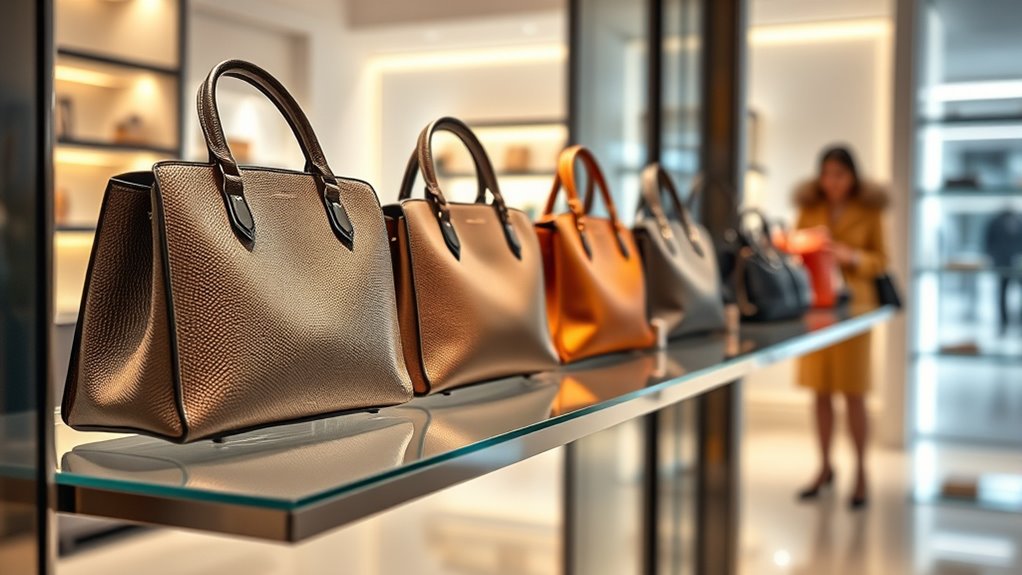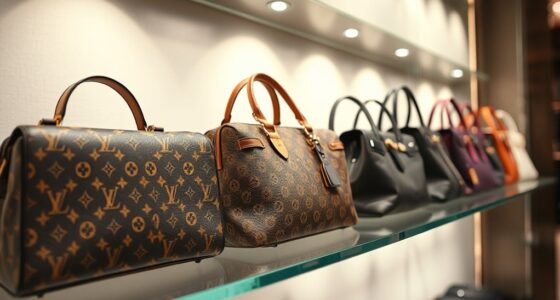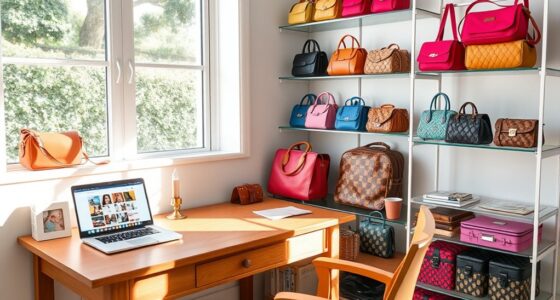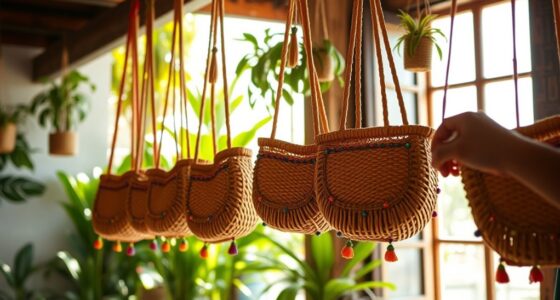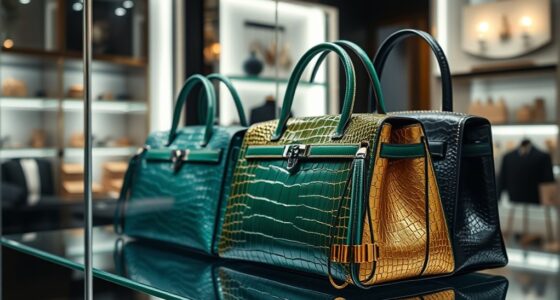Strategic handbag placement in stores activates your brain’s emotional and decision-making centers, subtly guiding your choices. Proper visual cues like bright colors, contrasts, and lighting draw your attention and create emotional connections with products. High-traffic spots and eye-level displays engage your sensory and subconscious mind, influencing impulse buys. If you want to understand how these techniques work beneath your awareness and shape your shopping habits, keep exploring the fascinating link between neuroscience and retail design.
Key Takeaways
- Handbag placement at eye level activates the brain’s sensory and value evaluation regions, increasing perceived desirability and purchase likelihood.
- Strategic display areas near fitting rooms or checkout trigger impulse centers and emotional responses, boosting sales.
- Bright lighting and contrasting colors highlight handbags, engaging visual and emotional pathways that influence buying decisions.
- Visual cues like positioning and lighting tap into subconscious processes, guiding attention and shaping preferences without awareness.
- Grouped or highlighted handbags foster familiarity and emotional connection, activating reward centers and reinforcing purchase intent.
The Role of Visual Cues in Shopper Attraction
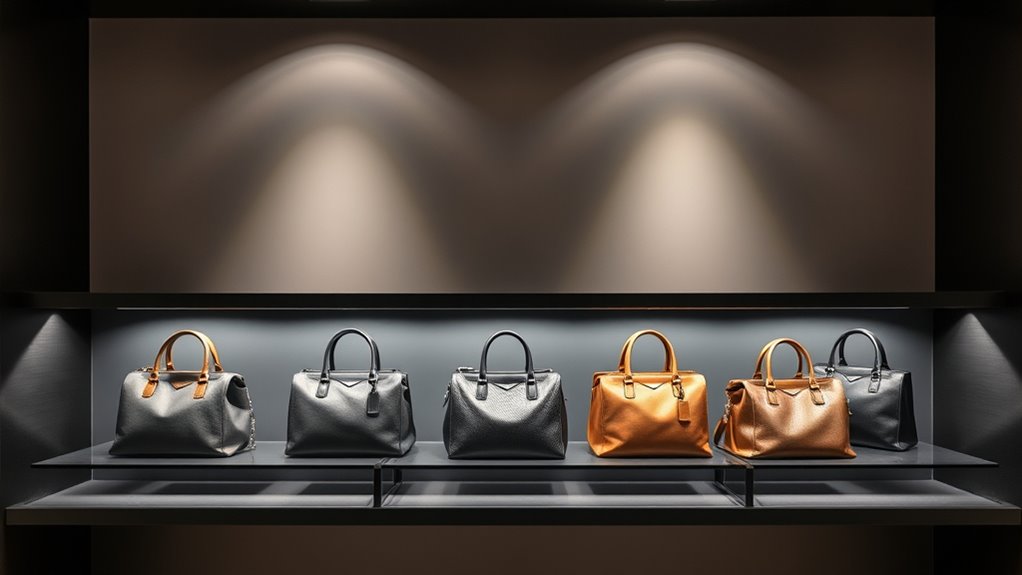
Visual cues play a crucial role in capturing shoppers’ attention and guiding their purchasing decisions. When you design your displays with strong visual cues, you enhance sensory engagement, making the shopping experience more immersive. Bright colors, appealing contrasts, and clear signage draw the eye and evoke an emotional appeal that resonates with shoppers. These visual elements create an immediate connection, encouraging exploration and influencing choices. By appealing to the senses, you make the display memorable, increasing the likelihood of a purchase. Effective visual cues don’t just catch attention; they establish an emotional bond, making shoppers feel more connected to the product. When you leverage sensory engagement through compelling visuals, you tap into subconscious triggers that drive buying behavior.
How Spatial Positioning Influences Consumer Behavior
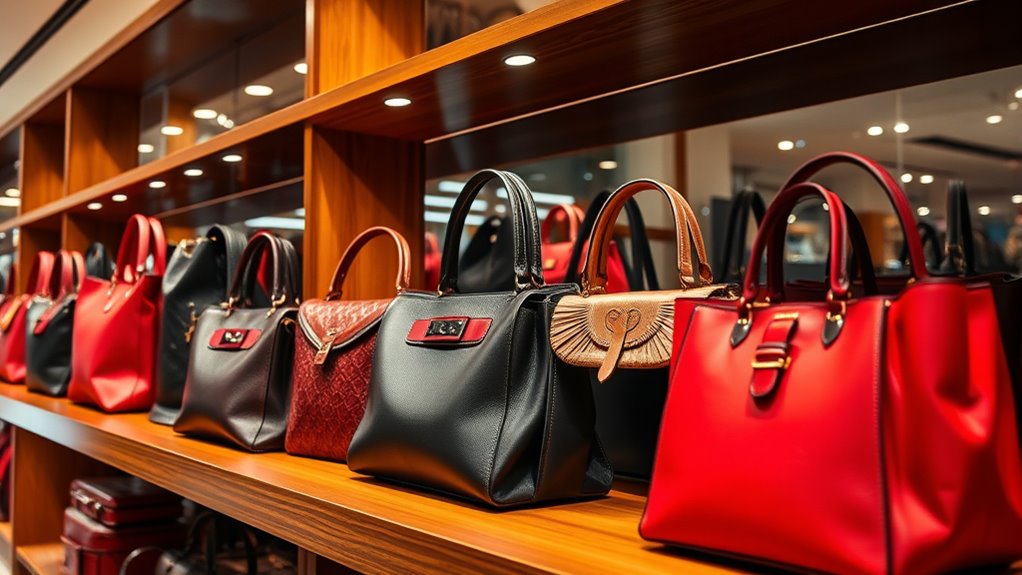
The placement of products within a retail space can considerably influence how you behave and make decisions. When items are positioned strategically, they enhance your sensory engagement, making products more appealing and memorable. For example, placing handbags at eye level or near high-traffic areas helps you notice and remember them through spatial memory. This positioning taps into how your brain encodes spatial details, making it easier to recall specific items later. Additionally, visual cues in the environment can further direct your attention to certain products, increasing the likelihood of purchase. By aligning product placement with natural movement patterns, stores subtly guide you toward certain choices without you realizing it. Effective spatial positioning creates a seamless shopping experience that increases the likelihood of impulse buys and brand recall. Moreover, understanding the role of peripheral vision in retail environments can help marketers design displays that influence your attention even when you’re not directly looking at them. Your brain’s spatial encoding plays a crucial role in how you process and remember these visual arrangements, further impacting your purchasing behavior. When store layouts incorporate customer flow patterns, they can strategically influence movement and attention zones to maximize sales. Ultimately, your environmental considerations play a vital role in shaping your purchasing decisions.
The Impact of Color and Lighting on Handbag Appeal
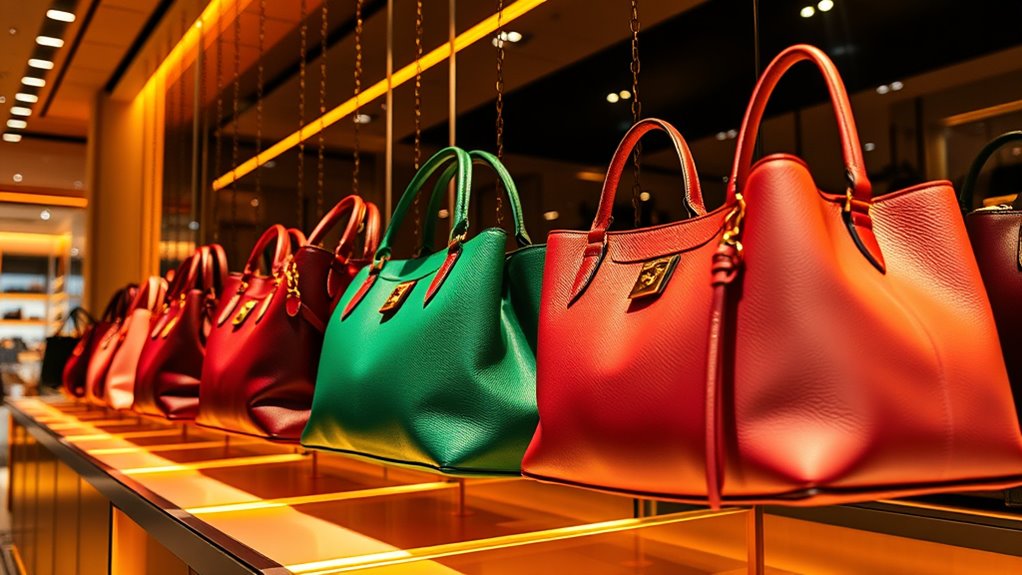
Color and lighting play a vital role in attracting your attention and shaping how appealing a handbag looks. Bright lighting can highlight details, while strategic contrast makes products stand out. Understanding these visual cues helps you see how retailers influence your perception of handbag desirability. Additionally, the use of visual appeal through color schemes and lighting effects can enhance a product’s attractiveness and influence purchasing decisions. Recent studies in the field of neuroscience of visual perception reveal how specific light intensities and color combinations can trigger emotional responses, further affecting consumer choices. Moreover, awareness of AI-driven marketing strategies shows how retailers analyze consumer responses to optimize display setups for maximum impact. The placement of handbags in relation to other products also leverages product positioning principles to subtly guide your shopping behavior. Incorporating insights from retail psychology, stores can design displays that subtly encourage more impulse buys and brand loyalty.
Color Psychology Effects
Colors and lighting play an essential role in shaping how handbags attract customers, as they influence emotions and perceptions instantly. The right color palette enhances emotional resonance, making shoppers feel connected to your products. Bright, bold hues evoke excitement and confidence, while softer tones foster elegance and calmness. Consistent color choices reinforce your brand identity, creating a memorable shopping experience. Consider these key effects:
- Warm colors like red and orange energize and draw attention.
- Cool shades such as blue and green convey trust and sophistication.
- Lighting that complements colors amplifies emotional impact and highlights handbag details. Color psychology techniques can be employed to craft compelling visual environments that align with these color strategies. Additionally, understanding how lighting and color interact can help optimize the overall display to influence purchasing behavior effectively. Exploring how visual perception influences consumer responses can further enhance your display design.
Lighting Intensity Influence
Lighting intensity markedly influences how handbags attract attention and evoke emotions. Bright lighting creates a lively retail ambiance, making products stand out and encouraging impulse buys. Conversely, softer lighting fosters a relaxed, intimate atmosphere that highlights craftsmanship and quality. In sensory marketing, adjusting lighting levels guides your mood and perception of the handbags, subtly influencing your desire to purchase. High-intensity lighting draws your eye to details, reinforcing the product’s appeal, while lower lighting emphasizes elegance and sophistication. Retailers strategically manipulate lighting to shape your shopping experience, making handbags appear more desirable or luxurious. The right lighting intensity doesn’t just illuminate; it engages your senses, shaping your emotional response and driving your buying behavior. Knowing that local regulations can influence retail environments helps retailers optimize lighting for maximum appeal. Additionally, understanding how lighting and color interact can help retailers create environments that maximize handbag desirability, utilizing visual perception principles to enhance attractiveness.
Visual Contrast Strategies
Visual contrast plays an essential role in making handbags stand out and catch your eye. By using color and lighting effectively, retailers create visual interest that draws you toward specific pieces. Texture contrast enhances this effect by highlighting differences in material, making certain handbags feel more tactile and appealing. Material differentiation can emphasize luxury or uniqueness, encouraging you to explore further. To maximize impact, stores often:
- Use bold, contrasting colors to highlight handbags against backgrounds
- Adjust lighting to create shadows that emphasize texture contrast
- Combine different materials, like leather and fabric, to enhance material differentiation
- Incorporate visual contrast strategies that leverage color and lighting to influence customer perception, which can be further optimized by understanding the underlying neuroscience principles behind visual attention. Additionally, employing perceptual mechanisms helps retailers design displays that naturally direct consumer focus. These strategies make handbags more visually appealing and memorable, guiding your attention toward the products you’re most likely to purchase and engage your senses more effectively.
Unconscious Decision-Making and Retail Environments
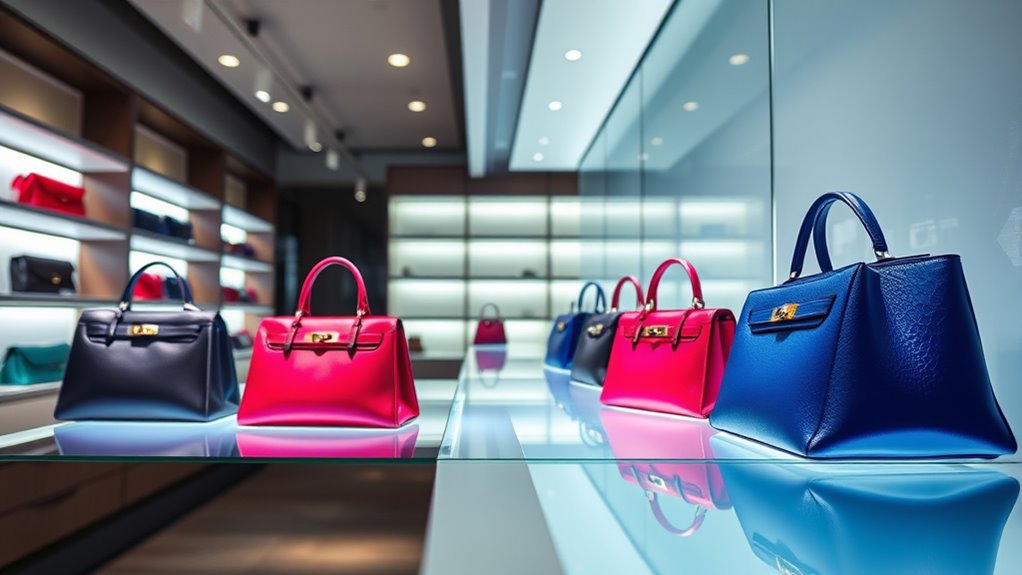
You might not realize it, but your choices in a retail space are heavily influenced by subconscious cues. Priming, visual signals, and subtle triggers shape your behavior without you noticing. Understanding these elements can reveal how stores guide your decisions effortlessly. For example, the strategic placement of high-demand items like handbags can trigger impulse purchases by utilizing visual cues, which subconsciously attract attention and influence buying behavior. Additionally, the use of hydrocolloid technology in certain product displays can subtly suggest effectiveness and prompt consideration, even if consumers are unaware of the influence. Furthermore, research shows that the contrast ratio of display lighting can significantly impact how prominently products stand out, subtly steering your focus toward certain items.
Priming Influences Choices
Priming plays a powerful role in shaping consumer choices without conscious awareness, especially within retail environments. Subtle cues can influence your decisions through techniques like sensorial marketing and brand storytelling. These cues activate associations and expectations, guiding your behavior effortlessly. For example:
- Pleasant scents can prime positive feelings, making you more receptive to certain products.
- Background music sets a mood that encourages you to linger or make quicker decisions.
- Strategic product placement, like handbags near fitting rooms, subtly suggests they’re desirable, reinforcing brand narratives.
Visual Cues Guide Behavior
Subtle visual cues in retail spaces can influence your behavior without you even realizing it. When you see well-placed displays or specific lighting, your eyes are naturally guided toward products. This visual guidance encourages tactile engagement, prompting you to touch and explore items, which deepens your connection with the product. Retailers often use scent marketing alongside visual cues to create a multisensory experience, subtly steering your mood and attention. For example, a cozy scent paired with warm lighting can make you feel more comfortable and inclined to linger or purchase. These cues work together unconsciously, shaping your decisions without overt persuasion. By understanding how visual cues guide your behavior, retailers craft environments that subtly influence your choices and enhance the shopping experience.
Subconscious Triggers Drive Purchases
Unconscious triggers in retail environments influence your purchasing decisions without you even realizing it. Your brain forms neural pathways linked to emotional triggers that are activated by specific store cues. These subtle signals bypass your conscious thought, guiding you toward certain products. For example, a well-placed handbag may evoke feelings of luxury or security, reinforcing your desire to buy. Retailers intentionally tap into these subconscious cues to shape your behavior. Consider how:
- Soft lighting enhances positive emotional responses
- Strategic product placement activates neural pathways associated with desire
- Background music triggers mood shifts that encourage spending
Brain Regions Activated by Strategic Product Placement
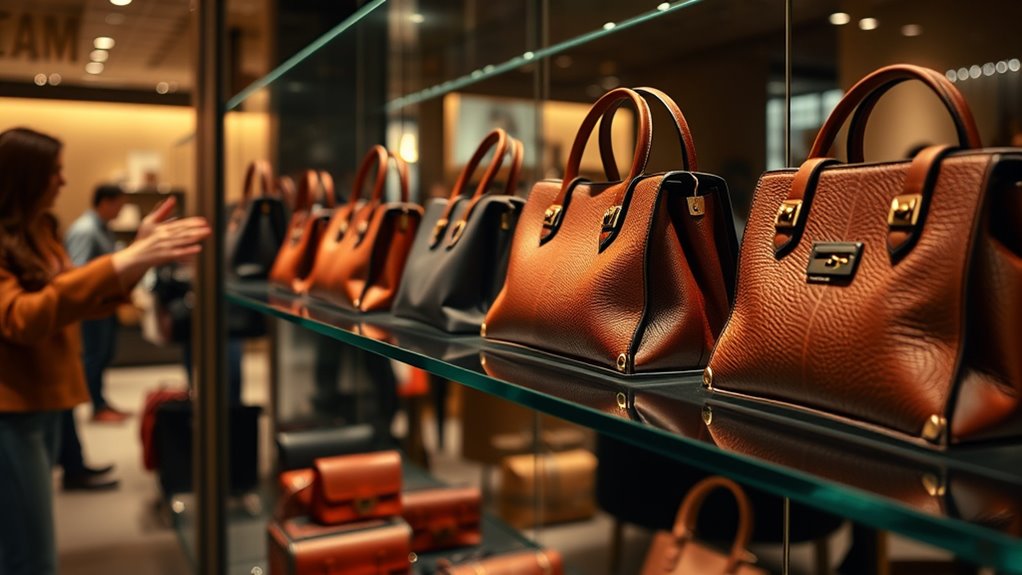
Strategic product placement in retail environments activates specific brain regions involved in decision-making and reward processing. When you see a handbag placed at eye level or near checkout counters, your brain engages areas like the ventromedial prefrontal cortex, which evaluates value, and the nucleus accumbens, responsible for reward anticipation. These regions process sensory integration and emotional resonance, making products feel more desirable.
| Placement Strategy | Brain Response |
|---|---|
| Eye-Level Position | Enhances sensory integration, increases desire |
| Near Checkout | Triggers reward centers, encourages impulse buying |
| Featured Displays | Engages emotional resonance, boosts perceived value |
| Groupings | Facilitates decision-making, creates familiarity |
| Highlighted Areas | Amplifies emotional response, heightens appeal |
Psychological Principles Behind Effective Display Design
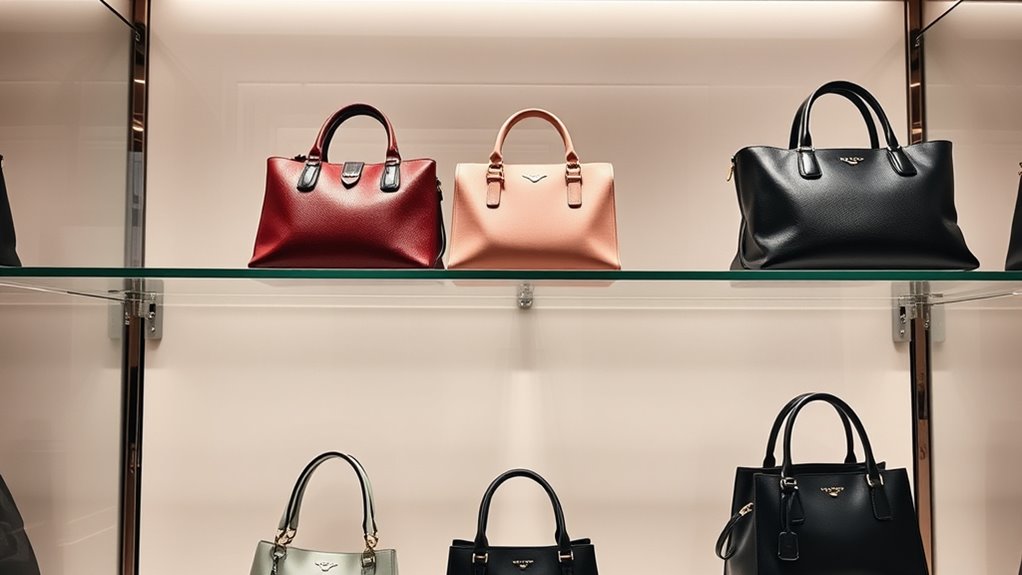
Effective display design leverages psychological principles to influence consumer behavior and enhance product appeal. By understanding retail psychology, you can tap into shopper motivation, guiding customers toward making a purchase. Key principles include:
- Simplicity: Clear, uncluttered displays help shoppers focus on products without distraction.
- Proximity: Grouping related items makes it easier for customers to see value and encourages additional purchases.
- Visual Hierarchy: Using size, color, and placement emphasizes priority products, drawing attention naturally.
Applying these principles taps into the subconscious cues that drive buying decisions. When your displays align with shopper motivation patterns, you create an environment that feels intuitive and compelling. This strategic approach boosts engagement and increases the likelihood of purchase, making your retail space more effective.
Practical Strategies for Retailers to Influence Purchases

To influence customer purchases, retailers should implement practical strategies that leverage psychological insights and display principles. Understanding retail psychology helps you craft environments that shape consumer perception favorably. Place high-demand or visually appealing items, like handbags, at eye level to capture attention effortlessly. Use strategic lighting to highlight key products, making them appear more desirable. Group related items together to encourage additional purchases through perceived value. Incorporate visual cues, such as color contrasts or directional signage, to guide shoppers naturally toward key displays. Also, consider the layout—an open, inviting space reduces buyer hesitation. By applying these tactics, you tap into subconscious decision-making processes, enhancing consumer perception and ultimately increasing sales. These strategies create a seamless shopping experience that encourages buying decisions without overt pressure.
Frequently Asked Questions
How Does Handbag Size Affect Consumer Attention in Displays?
Handbag size substantially influences your attention during retail displays. Larger handbags tend to dominate visibility, making them more noticeable and prompting quicker size perception. This increased visibility draws your eyes first, often leading you to perceive bigger bags as more valuable or stylish. Retailers leverage this by strategically placing handbags of different sizes, knowing that size perception affects your attraction and buying decision, guiding you toward certain options effortlessly.
What Role Does Scent Play Alongside Visual Cues in Shopping Decisions?
You’re influenced by sensory synergy, where scent complements visual cues to enhance your shopping experience. Olfactory influence taps into your subconscious, making certain products more appealing and memorable. When a pleasant fragrance surrounds a display, it can evoke positive emotions and increase the likelihood of purchase. Retailers strategically use scent alongside visuals to create an immersive environment that guides your decisions effortlessly, boosting sales without you even realizing it.
Can Display Placement Influence Impulse Purchases Beyond Visual Appeal?
Display placement profoundly influences your impulse purchases beyond just visual appeal by engaging your senses through sensory integration. When items are strategically positioned, they create a seamless shopping experience that enhances emotional engagement, making you more likely to buy on impulse. You might not realize it, but the right placement triggers subconscious cues, encouraging you to make spontaneous decisions. This clever tactic leverages your senses and emotions to boost sales effectively.
How Do Individual Shopper Differences Alter Display Effectiveness?
You might think displays are one-size-fits-all, but they’re not. Your personal shopping habits and emotional engagement dramatically change how effective a display is for you. A display that excites one shopper could fall flat for another. You respond to different cues based on your preferences, mood, and habits. Retailers who understand this customize displays, making each person feel uniquely drawn and more likely to buy.
Are There Cultural Variations in Perceptions of Handbag Display Strategies?
You should consider that cultural variations influence how people perceive handbag displays. Cultural symbolism and regional preferences play a big role; what appeals in one culture might not in another. You’ll find that color meanings, display styles, and packaging resonate differently across regions. By understanding these cultural nuances, you can adapt your display strategies to better attract diverse shoppers and boost sales effectively.
Conclusion
As you explore the secrets behind retail displays, you’ll realize that every placement, color, and light subtly shapes your choices. But what if the most powerful tricks are still hidden, waiting to be revealed? By understanding these psychological cues, you can open the true influence of store design—and perhaps, unknowingly, become a master of persuasion yourself. The real question remains: how much of your decision-making is truly in your control?
